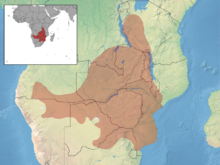Smith bush squirrel
| Smith bush squirrel | ||||||||||||
|---|---|---|---|---|---|---|---|---|---|---|---|---|

Smith bush squirrel |
||||||||||||
| Systematics | ||||||||||||
|
||||||||||||
| Scientific name | ||||||||||||
| Paraxerus cepapi | ||||||||||||
| ( Smith , 1836) |
The Smith bush squirrel ( Paraxerus cepapi ), also known as the common bush squirrel or yellow-footed bush squirrel , is a species of the African bush squirrel , a genus of squirrels . It is distributed in ten subspecies in large parts of southeastern Africa and forms social family groups.
Appearance and characteristics
The Smith's bush squirrel reaches a total length of about 35 centimeters, with the tail taking up about half the length. The weight varies, animals living in South Africa weigh around 200 grams.
The color of the fur on the top of the body can vary depending on the population . In the west of the distribution area, the squirrels are rather grayish in color, in the east brownish, although the animals living to the east can also have reddish-brown extremities and facial parts. The underside of the body is white, but often tends to be yellowish or beige in the eastern part of the range.
The physique is typical of species in the Paraxerus genus , but the tail is less bushy than that of some related species such as Paraxerus palliatus .
The differences between the ten subspecies of the Smith bush squirrel amount to minor differences in color and size and are difficult to determine.
distribution and habitat
Smith's bush squirrels are found throughout much of southeastern Africa. In addition to northern South Africa and southern Mozambique , they occur in Tanzania , Zambia , Zimbabwe , the Democratic Republic of the Congo , Botswana , southeastern Angola and parts of northeastern Namibia . The species chooses light forests and tree collections in the savannah as its preferred habitat . Nests are preferred to be built in knotholes and tree hollows, but there are also burrows that are inhabited.
Behavior and nutrition

The diurnal Smith bush squirrels show pronounced social behavior. They live together in family groups of different sizes, which territorially hold a territory of approx. 0.3 to 1.26 ha in size, which is especially aggressively defended by the males. The territory is marked by scent marks in the form of feces or saliva .
The family groups sleep together in a building and spend the day together. You identify yourself by the individual smell of the group.
In addition, an acoustic communication is pronounced in the species, which amounts to a wide variety of tones. The repertoire ranges from throaty gargles to whistles.
When there is danger from predators , the animals react differently. If a bird of prey is spotted in the air, the group members immediately flee to a hiding place. In the case of predators such as snakes or mongooses approaching on the ground , they show defensive behavior which is expressed in noises and body language. For example, the tail is thrown over the body.
nutrition
Smith's bush squirrels are omnivorous and feed on both plants and insects . Within the territory, the family groups also store food supplies.
Reproduction
The mating season includes the late summer and early autumn months. The females give birth to 1–3 pups which they suckle for approximately 6 weeks.
Systematics
The following subspecies exist:
- Paraxerus cepapi cepapi
- Paraxerus cepapi bororensis
- Paraxerus cepapi carpi
- Paraxerus cepapi cepapoides
- Paraxerus cepapi chobiensis
- Paraxerus cepapi phalaena
- Paraxerus cepapi quotus
- Paraxerus cepapi sindi
- Paraxerus cepapi soccatus
- Paraxerus cepapi yulei
Danger
The IUCN lists the Smith bush squirrel as “Least Concern”, ie not endangered.
literature
- Gus Mills, Lex Hes: Mammals of Southern Africa. An illustrated encyclopedia. Könmann, Cologne 1999, ISBN 3-8290-3610-8 .
- Ronald M. Nowak: Walker's Mammals of the World. 2 volumes. 6th edition. Johns Hopkins University Press, Baltimore MD et al. 1999, ISBN 0-8018-5789-9 .
- Richard W. Thorington Jr., Robert S. Hoffmann: Family Sciuridae. In: Don E. Wilson , DeeAnn M. Reeder (Eds.): Mammal Species of the World. A taxonomic and geographic Reference. Volume 2. 3rd edition. Johns Hopkins University Press, Baltimore MD 2005, ISBN 0-8018-8221-4 , pp. 754-818.
Web links
- IUCN on Paraxerus cepapi
